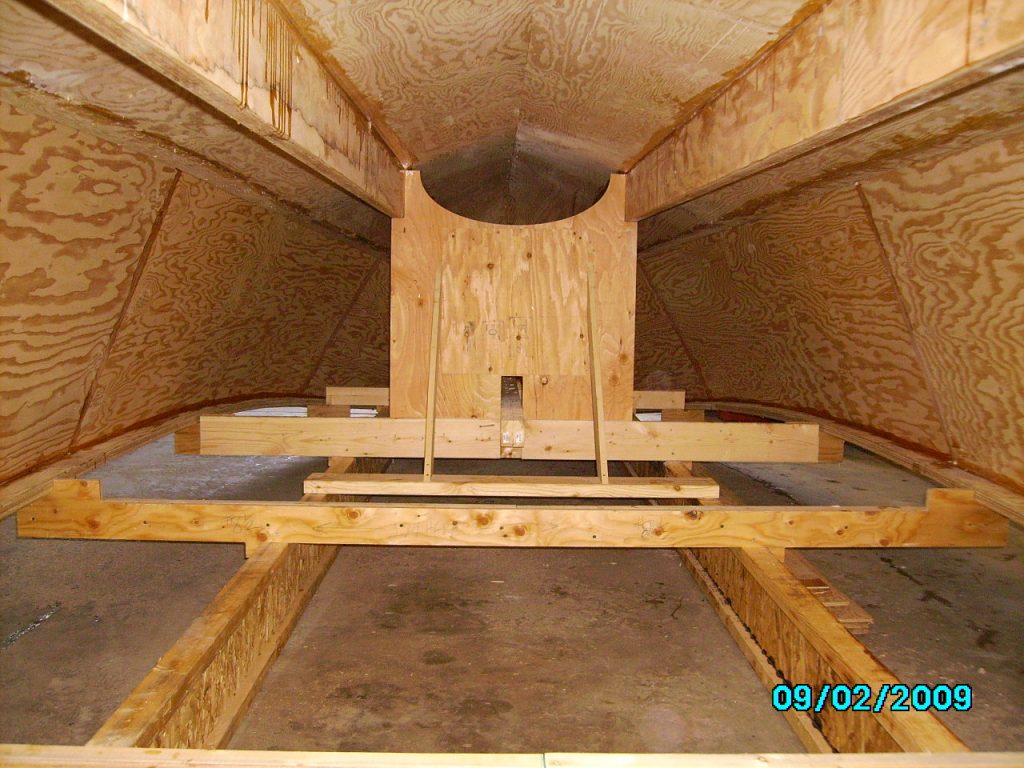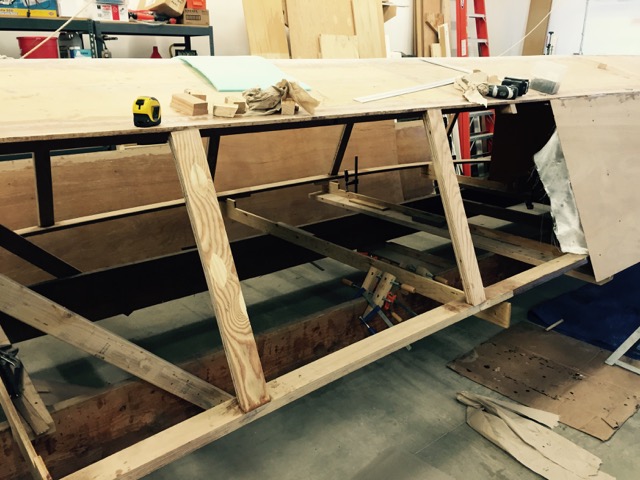I now have the stem, transom, shelves and stringers in place and glued together as required. Now is the time to try the bottom to see how it fits with the bow and bow end of the stringers. I made adjustments largely by moving the bottom back and forth until I liked the fit. Then we spread epoxy.
[The “we” at this point is my son, Erik and his brother-in-law, Levi. Those two did a fantastic job.]
First coat is plain epoxy, then we spread the “peanut butter”, i.e. thickened epoxy on all contact surfaces. At least in my case, most of the surfaces are not 100% matched. 🙂 That is, gaposis abounds. Renn is oft quoted as saying as long as you can’t throw a cat through the hole, you’re good. So the solution is a gap-filling mixture of epoxy. To tell the truth, overall, the fit was pretty good.
In preparation for the mating up of the bottom, transom and stem, I needed to work out a means of ensuring that once I’ve got it fitted them all together, I can return the bottom to the best fit location. The bow is pretty much located by virtual of its shape against the stem. But at the transom I needed to ensure that the bottom sat exactly where we had it fitted. There are a myriad of ways of doing this and nothing is “right” except what does the job for you. In my case, I used some quarter inch dowels positioned one on each side of the stringer beyond the transom on the parts that get trimmed off later. Below you can see their holes and my mark indicating where the stringer should be. In practice, it worked like a champ and I wound up with the bottom exactly where I wanted it. So now I have the bottom on, here a couple of shots from underneath. The first shows the two stringers, supported by the horse and transom in position up against the bottom, looking toward the bow. The picture shows the sides on, but I don’t have them installed yet at this stage. (While it fairly represents my situation, I have to confess that I stole the picture from another builder whose name escapes me at the moment. Msg me if you want it removed. I’ll definitely understand. )
So now I have the bottom on, here a couple of shots from underneath. The first shows the two stringers, supported by the horse and transom in position up against the bottom, looking toward the bow. The picture shows the sides on, but I don’t have them installed yet at this stage. (While it fairly represents my situation, I have to confess that I stole the picture from another builder whose name escapes me at the moment. Msg me if you want it removed. I’ll definitely understand. )

This picture from a later step in the build process shows the tip of a stringer at the bow.
Once the bottom is glued down, there is a couple of short sections of ~1/4″ ply that need to be applied to a bow section of the bottom. The picture below shows the bottom at the bow. To the left lower quadrant of the picture you can see a line of packing tape used to keep any squeeze out from getting on the rest of the boat. From there forward, a second layer of plywood must be applied. Renn has this part of the bottom made up from two thinner layers to facilitate the sharper bends required by the bottom. The first layer that you see below has been treated pretty much like the rest of the bottom, but the outside here is where a second layer is added. The light brown packing tape defines its outline with the piece running across the bottom defining the location of the scarf. At that point the two 1/4″ pieces are scarfed onto the thicker, single layer bottom pieces.
 Below, Becky and I have mixed up the several batches of epoxy and carefully laid the second layer of plywood in place. You can see the board holding the two parts of the scarf together and all the other screws with fender washers used to make sure that the whole piece of ply is in contact with the first layer. To get this in the best position, several locator marks and locator screws had to be placed before application of epoxy and then the second layer. I started driving screws with fender washers beginning with the scarf and worked forward. I led with the bottom edge against the chine shelf as that had to be what it was, whatever that was. I let any extra ply work out the top where I could trim it easily.
Below, Becky and I have mixed up the several batches of epoxy and carefully laid the second layer of plywood in place. You can see the board holding the two parts of the scarf together and all the other screws with fender washers used to make sure that the whole piece of ply is in contact with the first layer. To get this in the best position, several locator marks and locator screws had to be placed before application of epoxy and then the second layer. I started driving screws with fender washers beginning with the scarf and worked forward. I led with the bottom edge against the chine shelf as that had to be what it was, whatever that was. I let any extra ply work out the top where I could trim it easily.
 Below is what it looked like from the bow right after we finished with the first side.
Below is what it looked like from the bow right after we finished with the first side.
 And, a picture of what it all looked like once the other side was on and all the screws have been pulled.
And, a picture of what it all looked like once the other side was on and all the screws have been pulled.
 Almost all the clamp screws went clear through to the underside of the bottom, which holes I needed to plug with epoxy. The problem is that the epoxy would run right through. My solution was to cover each of the screw holes with a small piece of green masking tape, then once the epoxy has set up, I could remove them. That worked fairly well, not great but well enough. One of the guys on the Tolman forum pointed out that when it was all said and done, those epoxy filled holes were functionally just like rivets.
Almost all the clamp screws went clear through to the underside of the bottom, which holes I needed to plug with epoxy. The problem is that the epoxy would run right through. My solution was to cover each of the screw holes with a small piece of green masking tape, then once the epoxy has set up, I could remove them. That worked fairly well, not great but well enough. One of the guys on the Tolman forum pointed out that when it was all said and done, those epoxy filled holes were functionally just like rivets.
 The picture above also shows the forward location of a stringer once the bottom is glued on.
The picture above also shows the forward location of a stringer once the bottom is glued on.
I forgot to mention that like everyone else building these boats, I found the initial 1/4″ layer was up away from the stringers. In my case and I suspect several others, the gap was a good 3/4″ in the worst part. Renn tells us that when we get on top to screw the bottom to the stringers, our weight will being them into contact. Sure enough he was right. But then if I recall correctly, he built over 80 of them before he wrote the how-to book. That’s pretty good credibility if you ask me.
OK, now I have the bottom epoxied to the stem, transom and stringers, we can move on to the sides. By the way, here’s what the transom looks like with the stringers and bottom panels cut to length and the bottom epoxied to the transom and stringers.
 However, before we can actually hang the sides, I need to install what Renn calls “frames”. The book calls for 2x material, but after looking through my collection of 2x4s I could see I was either going to have to buy several more, being much more careful about how straight, etc. they are. Mine had been in the shop for months if not years and as they dried, they cupped, twisted, warped etc. New ones would either do this after installed on the boat or have to sit for an indeterminate amount time. Then it dawned on my that I had several pieces of good plywood. Why not laminate up the frames out of that?! They would be a lot stronger than a 2×4 and much more dimensionally stable.
However, before we can actually hang the sides, I need to install what Renn calls “frames”. The book calls for 2x material, but after looking through my collection of 2x4s I could see I was either going to have to buy several more, being much more careful about how straight, etc. they are. Mine had been in the shop for months if not years and as they dried, they cupped, twisted, warped etc. New ones would either do this after installed on the boat or have to sit for an indeterminate amount time. Then it dawned on my that I had several pieces of good plywood. Why not laminate up the frames out of that?! They would be a lot stronger than a 2×4 and much more dimensionally stable.
A close up of the laminated frames.
Once the frames are in hand, I had to figure out placement. Renn notes that to some extent this depends on the location of the cabin bulkhead. Since I wasn’t willing to guess at this stage, I had to place them somewhat arbitrarily. But I still wasn’t sure where I wanted them. Given plenty of frame material, I decided to shotgun it. I doubled the number typically installed (two). While they add a bit of weight, the payoff in strength is considerable. So I have what you see below.
 Another thing that I did before I started placing frames, was to brace the shelves to fair out the transom end. As other builders have found, the weight of the transom on the end of the shelves bends the shelves down after the last building jig. In my opinion, that would not look good, so I incorporated that in the gentle arch of the shelves. Once you click on the picture and have the large size, you will be able to see that I’ve placed a 2×4 under the shelf at the third jig so I have a fair curve from bow to transom.
Another thing that I did before I started placing frames, was to brace the shelves to fair out the transom end. As other builders have found, the weight of the transom on the end of the shelves bends the shelves down after the last building jig. In my opinion, that would not look good, so I incorporated that in the gentle arch of the shelves. Once you click on the picture and have the large size, you will be able to see that I’ve placed a 2×4 under the shelf at the third jig so I have a fair curve from bow to transom.
Below is one side with a side panel in place so you can see how sides mate up with the rest of the boat.


